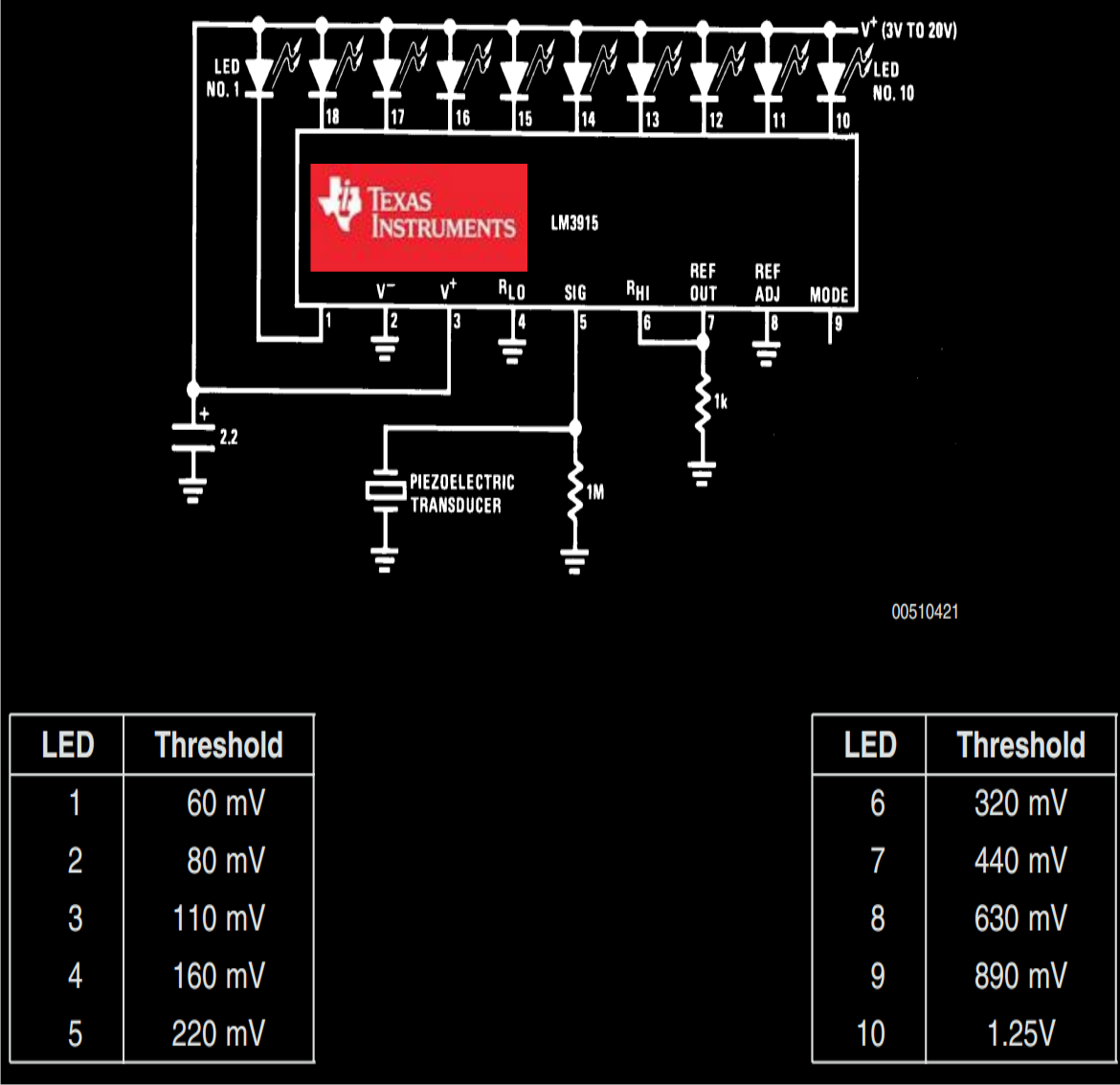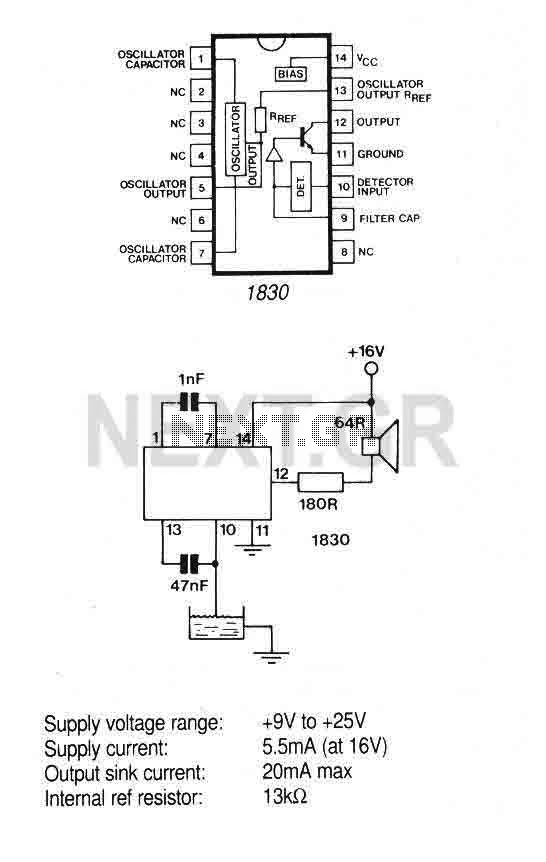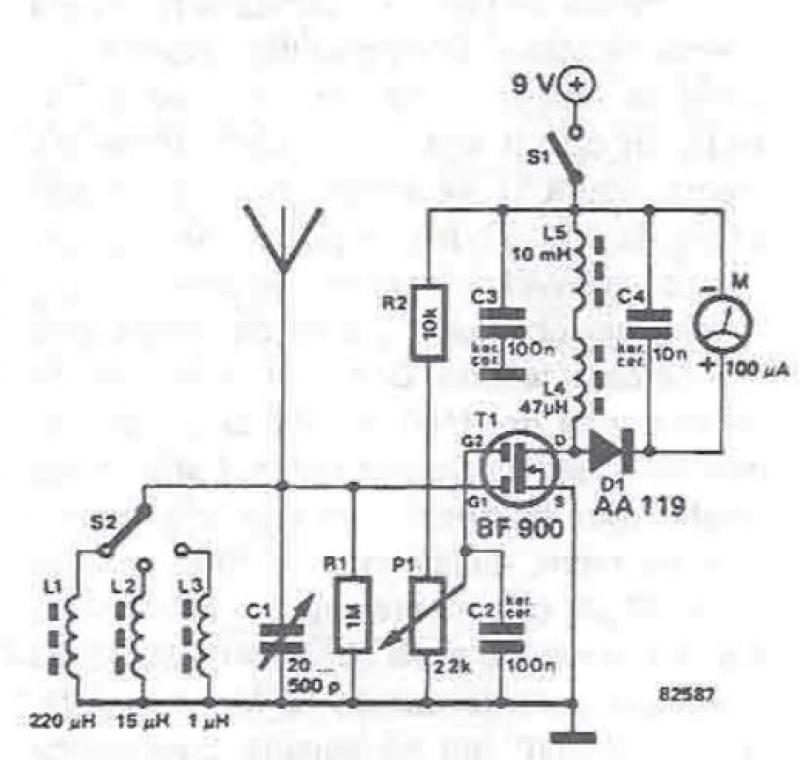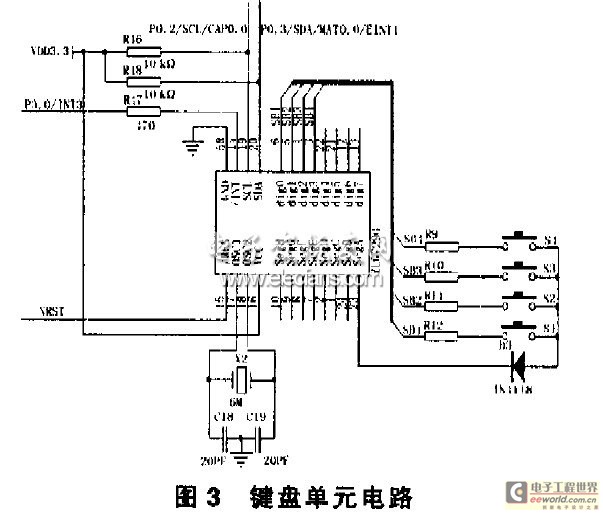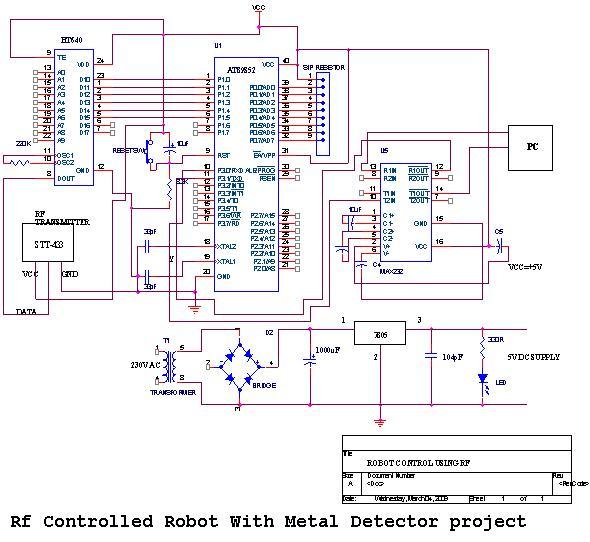
active ir motion detector
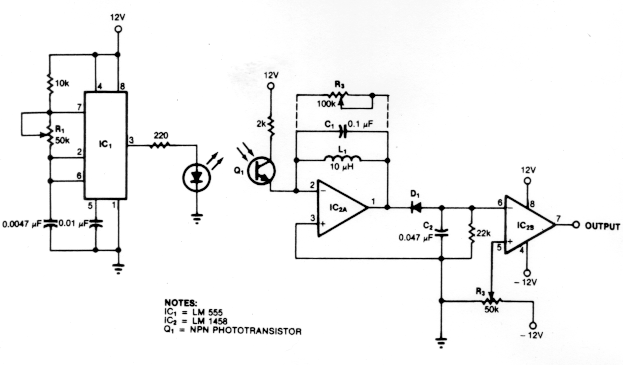
The circuit illustrates the operation of an ultrasonic motion detector, which consists of two transducers: one that emits ultrasonic waves and another that detects reflections from various objects in the vicinity. When no objects are in motion, the reflected waves reach the receiver in a constant phase. However, if an object moves, the received signal experiences a phase shift. A phase comparator identifies this shifted phase and generates a triggering pulse for the alarm. Ultrasonic motion detectors have advantages and disadvantages compared to other motion detection types. They are highly sensitive and react very quickly, but they can also be triggered by normal environmental vibrations, such as those caused by passing vehicles or aircraft. Some motion detectors utilize infrared sensors to mitigate this issue, although these detectors can also experience problems. In passive infrared motion detectors, an infrared-sensitive phototransistor is placed in the monitored area to detect the infrared radiation emitted by an intruder's body, thereby triggering the alarm. However, such detectors can be falsely activated by warm air movement or other disturbances that alter the infrared radiation levels. To address this, newer systems employ two infrared sensors monitoring different zones within the protected area. The logic in the system activates the alarm only when both zones are sequentially triggered, which typically occurs when a person traverses the monitored area. An active infrared motion detector consists of two housings: one containing an infrared-emitting diode and an infrared-sensitive phototransistor, while the other houses an infrared reflector. When positioned at an entrance, these housings create an invisible beam; interrupting this beam triggers the alarm. Active motion detectors are generally more reliable than passive ones, but they require precise alignment during installation to avoid false triggering from minor movements. For this project, an active infrared motion detector was constructed. Initially, both an infrared and an ultrasonic detector were planned, but the ultrasonic detector was deemed too time-consuming for a three-week project. Instead, the focus shifted to developing an ambient light-ignoring motion detector based on the active infrared concept. This motion detector operates by detecting interruptions in a 5 kHz modulated pulsating beam transmitted by an infrared diode and received by an infrared transistor, which activates the alarm. The schematic provided illustrates the transmitter circuit that generates a 5 kHz modulated infrared beam. The receiver circuit employs a resonance-tuned narrowband amplifier to minimize sensitivity to stray light. Components C1 and L1 in the feedback loop of IC2A ensure that the operational amplifier only processes frequencies near the 5 kHz modulation rate of the LED.
The ultrasonic motion detector circuit operates by utilizing two key transducers: an ultrasonic transmitter and an ultrasonic receiver. The transmitter emits ultrasonic waves that propagate through the environment. These waves reflect off objects in the vicinity and return to the receiver. Under static conditions, the receiver detects these reflected waves with a consistent phase. However, when an object moves within the detection range, the phase of the reflected waves shifts, which is detected by a phase comparator circuit. This phase comparator generates a pulse signal that triggers an alarm, indicating motion.
The advantages of ultrasonic motion detectors include their high sensitivity and rapid response time, making them suitable for various applications. However, they also have drawbacks, such as susceptibility to false alarms triggered by environmental vibrations, which can occur due to external factors like traffic or aircraft overhead. To mitigate this issue, some systems incorporate infrared sensors, which detect changes in infrared radiation levels caused by warm bodies.
Passive infrared (PIR) motion detectors function by monitoring infrared radiation emitted by human bodies. The core component is an infrared-sensitive phototransistor that detects variations in infrared levels. However, these detectors are prone to false triggering from non-intrusive sources, such as warm air currents. To enhance reliability, advanced PIR systems utilize dual-zone monitoring, where two sensors are placed in separate zones. The alarm is activated only when both zones are sequentially triggered, indicating the presence of a moving person.
Active infrared motion detectors consist of two housings: one housing an infrared-emitting diode and a phototransistor, while the other contains an infrared reflector. When installed at an entrance, these housings create an invisible beam of infrared light. The detection mechanism is straightforward; when a person crosses the beam, the interruption triggers the alarm. Although active detectors are generally more reliable than passive ones, they require careful alignment during installation to prevent false alarms caused by misalignment.
The project focuses on constructing an active infrared motion detector that ignores ambient light. The design employs a 5 kHz modulated infrared beam transmitted by an infrared diode. The receiver circuit includes a narrowband amplifier tuned to the modulation frequency, which reduces sensitivity to ambient light interference. Key components, such as capacitors and inductors in the feedback loop, ensure that the operational amplifier responds primarily to the desired modulation frequency, enhancing the detector's performance in various lighting conditions.Circuit shows the operation of an ultrasonic motion detector. There are two transducers, one emits an ultrasonic wave and the other picks up reflections from the different objects in the area. The reflected waves arrive at the receiver in constant phase if none of the objects in the area are moving.
If something moves, the received signal is shifted in phase. A phase comparator detects the shifted phase and sends a triggering pulse to the alarm. Ultrasonic motion detectors have certain advantages and disadvantages when compared with other types of motion detectors. The main advantages is that they are very sensitive and extremely fast acting. However, the largest problem with this type of motion detector is that it sometimes responds to normal environmental vibration that can be caused by a passing car or a plane overhead.
Some types of motion detectors use infrared sensors to avoid this problem, but even these detectors have some problems. In passive infrared motion detectors, a sensor containing an infrared-sensitive phototransistor is placed in the area to be protected.
Circuitry within the sensor detects the infrared radiation emitted by the intruder`s body and triggers the alarm. The problem with using this type of detector is that it can be falsely triggered by warm air movement or other disturbances that can alter the infrared radiation levels in an area.
In order to prevent this problem, newer systems use tw1o infrared sensors which monitor different zones within a protected area. Logic within system triggers the alarm only when the tw1o zones are activated in sequence, as would occur if a person walked through the protected area.
Figure 2 shows the operation of an active infrared motion detector. In the active system each sensor consists of tw1o housings. One housing contains an infrared-emitting diode and an infrared-sensitive phototransistor. The other housing contains an infrared reflector. When positioned in front of an entrance to a protected area, the tw1o housings establish an invisible beam. A person entering the area interrupts the beam causing an alarm to be triggered. An active motion detector is much more reliable than a passive one, but it requires careful alignment when it is installed.
The detector can be falsely triggered if one of the housings moves slightly and causes a discontinuous beam. For our project, we decided to construct an active infrared motion detector. Originally, we wanted to build both an IR and an ultrasonic detector, but we decided that an ultrasonic detector would require too much time for a three week project.
However, we also decided that just building an IR motion detector would probably be a trivial exercise. So, we decided to expand on the concept by building an ambient light ignoring motion detector. This type of motion detector uses the same basic concept as the active infrared motion detector. An interruption in a 5 kHz modulated pulsating beam that is transmitted by an infrared diode and received by an infrared transistor sets off the alarm.
A schematic of this motion detector is given in Figure 3. The circuit on the left is the transmitter circuit that establishes a 5 kHz modulated infrared beam. As you can see from the schematic of the receiver circuit, a resonance-tuned narrowband amplifier reduces the detector`s sensitivity to stray light. C1 and L1 in IC2A`s feedback loop cause the op amp to pass only those frequencies at or near the LED`s 5 kHz modulation rate.
IC2B`s 🔗 External reference
The ultrasonic motion detector circuit operates by utilizing two key transducers: an ultrasonic transmitter and an ultrasonic receiver. The transmitter emits ultrasonic waves that propagate through the environment. These waves reflect off objects in the vicinity and return to the receiver. Under static conditions, the receiver detects these reflected waves with a consistent phase. However, when an object moves within the detection range, the phase of the reflected waves shifts, which is detected by a phase comparator circuit. This phase comparator generates a pulse signal that triggers an alarm, indicating motion.
The advantages of ultrasonic motion detectors include their high sensitivity and rapid response time, making them suitable for various applications. However, they also have drawbacks, such as susceptibility to false alarms triggered by environmental vibrations, which can occur due to external factors like traffic or aircraft overhead. To mitigate this issue, some systems incorporate infrared sensors, which detect changes in infrared radiation levels caused by warm bodies.
Passive infrared (PIR) motion detectors function by monitoring infrared radiation emitted by human bodies. The core component is an infrared-sensitive phototransistor that detects variations in infrared levels. However, these detectors are prone to false triggering from non-intrusive sources, such as warm air currents. To enhance reliability, advanced PIR systems utilize dual-zone monitoring, where two sensors are placed in separate zones. The alarm is activated only when both zones are sequentially triggered, indicating the presence of a moving person.
Active infrared motion detectors consist of two housings: one housing an infrared-emitting diode and a phototransistor, while the other contains an infrared reflector. When installed at an entrance, these housings create an invisible beam of infrared light. The detection mechanism is straightforward; when a person crosses the beam, the interruption triggers the alarm. Although active detectors are generally more reliable than passive ones, they require careful alignment during installation to prevent false alarms caused by misalignment.
The project focuses on constructing an active infrared motion detector that ignores ambient light. The design employs a 5 kHz modulated infrared beam transmitted by an infrared diode. The receiver circuit includes a narrowband amplifier tuned to the modulation frequency, which reduces sensitivity to ambient light interference. Key components, such as capacitors and inductors in the feedback loop, ensure that the operational amplifier responds primarily to the desired modulation frequency, enhancing the detector's performance in various lighting conditions.Circuit shows the operation of an ultrasonic motion detector. There are two transducers, one emits an ultrasonic wave and the other picks up reflections from the different objects in the area. The reflected waves arrive at the receiver in constant phase if none of the objects in the area are moving.
If something moves, the received signal is shifted in phase. A phase comparator detects the shifted phase and sends a triggering pulse to the alarm. Ultrasonic motion detectors have certain advantages and disadvantages when compared with other types of motion detectors. The main advantages is that they are very sensitive and extremely fast acting. However, the largest problem with this type of motion detector is that it sometimes responds to normal environmental vibration that can be caused by a passing car or a plane overhead.
Some types of motion detectors use infrared sensors to avoid this problem, but even these detectors have some problems. In passive infrared motion detectors, a sensor containing an infrared-sensitive phototransistor is placed in the area to be protected.
Circuitry within the sensor detects the infrared radiation emitted by the intruder`s body and triggers the alarm. The problem with using this type of detector is that it can be falsely triggered by warm air movement or other disturbances that can alter the infrared radiation levels in an area.
In order to prevent this problem, newer systems use tw1o infrared sensors which monitor different zones within a protected area. Logic within system triggers the alarm only when the tw1o zones are activated in sequence, as would occur if a person walked through the protected area.
Figure 2 shows the operation of an active infrared motion detector. In the active system each sensor consists of tw1o housings. One housing contains an infrared-emitting diode and an infrared-sensitive phototransistor. The other housing contains an infrared reflector. When positioned in front of an entrance to a protected area, the tw1o housings establish an invisible beam. A person entering the area interrupts the beam causing an alarm to be triggered. An active motion detector is much more reliable than a passive one, but it requires careful alignment when it is installed.
The detector can be falsely triggered if one of the housings moves slightly and causes a discontinuous beam. For our project, we decided to construct an active infrared motion detector. Originally, we wanted to build both an IR and an ultrasonic detector, but we decided that an ultrasonic detector would require too much time for a three week project.
However, we also decided that just building an IR motion detector would probably be a trivial exercise. So, we decided to expand on the concept by building an ambient light ignoring motion detector. This type of motion detector uses the same basic concept as the active infrared motion detector. An interruption in a 5 kHz modulated pulsating beam that is transmitted by an infrared diode and received by an infrared transistor sets off the alarm.
A schematic of this motion detector is given in Figure 3. The circuit on the left is the transmitter circuit that establishes a 5 kHz modulated infrared beam. As you can see from the schematic of the receiver circuit, a resonance-tuned narrowband amplifier reduces the detector`s sensitivity to stray light. C1 and L1 in IC2A`s feedback loop cause the op amp to pass only those frequencies at or near the LED`s 5 kHz modulation rate.
IC2B`s 🔗 External reference
